Before we discuss the most aggressive sharks in U.S. waters, it’s worth considering why every conversation about sharks seems to dwell on how to keep these fascinating fish from biting us.
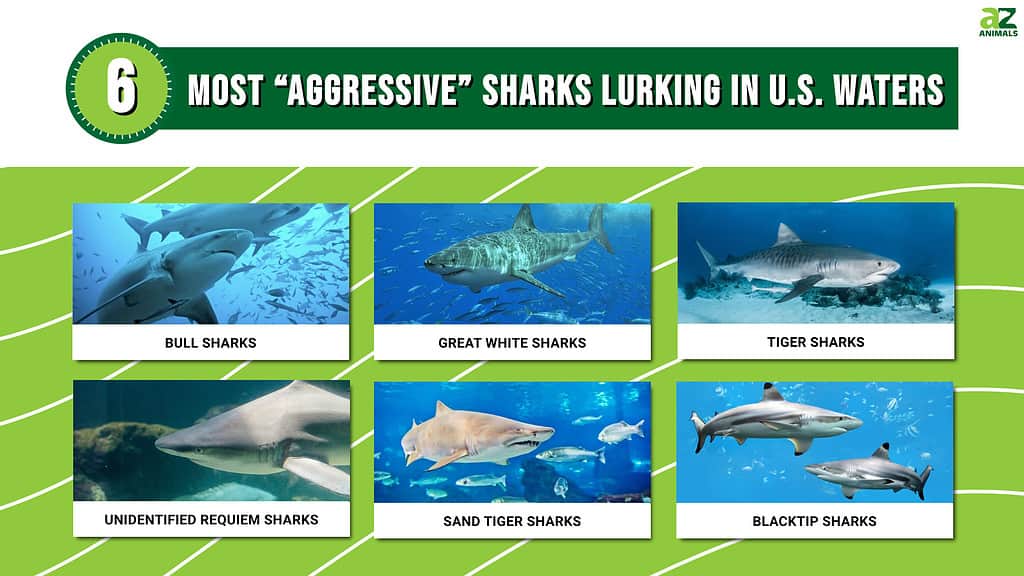
Maybe that’s because it’s easy to get hyperbolic when talking about sharks. They seem to be creatures of extremes. As a group, sharks have been around for 400 million years; they’ve outlived the dinosaurs and many other extinct species. Their family includes the largest fish on earth, the whale shark, which can weigh 15 tons and measure 60 feet long (and doesn’t bite anyone, btw, it feeds on plankton). Sharks have amazing senses, including sensors along their body that detect underwater sounds across vast distances, and the ability to detect electrical activity in the bodies of their prey.
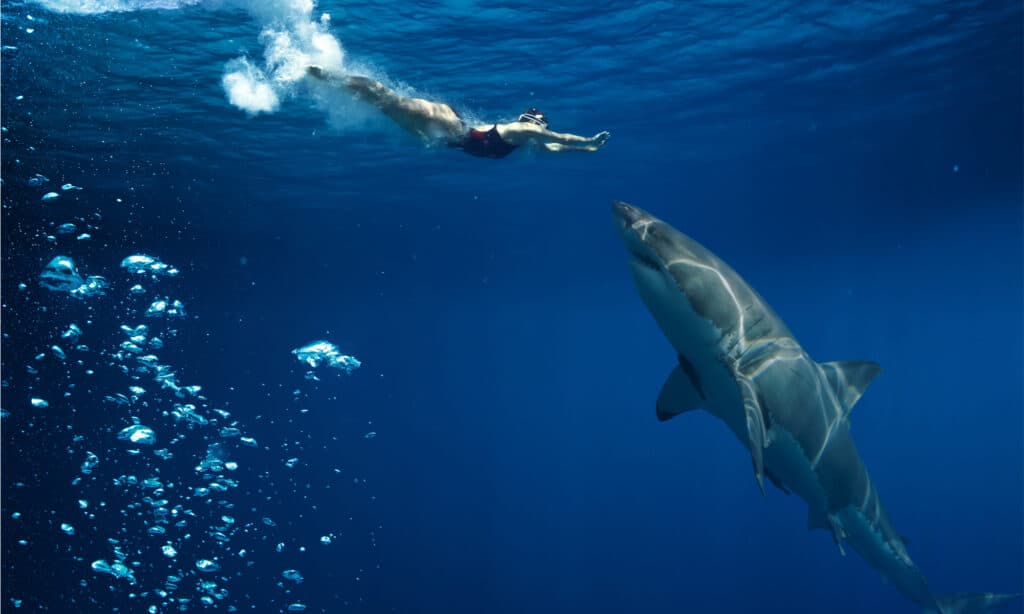
Sharks know you’re there, but can’t always tell what you are.
©Willyam Bradberry/Shutterstock.com
With all that going for them, if sharks really felt like eating human beings on the reg, there’s probably not much we could do about it. But statistics make it pretty clear that these predators don’t consider humans to be on the menu. In the decade from 2010-2019, for example, there were only 803 shark attacks recorded worldwide, according to the University of Florida’s International Shark Attack File (ISAF). The most common attack is a single chomp-and-run bite, which probably occurs because a shark mistook a human for its usual prey, then swam away after realizing its mistake.
The average person’s likelihood of being killed by a shark is 1 in 4,332,817, less than the risk of being killed by lightning (1 in 79,746) or in a car accident (1 in 84). There are maybe 12 shark bites a year in U.S. waters, while in New York City alone more than a thousand people a year get bitten by…other people. Yet how often do we ask ourselves if someone is going to bite us while we’re buying groceries or taking a walk?
How Aggressive Are Sharks?
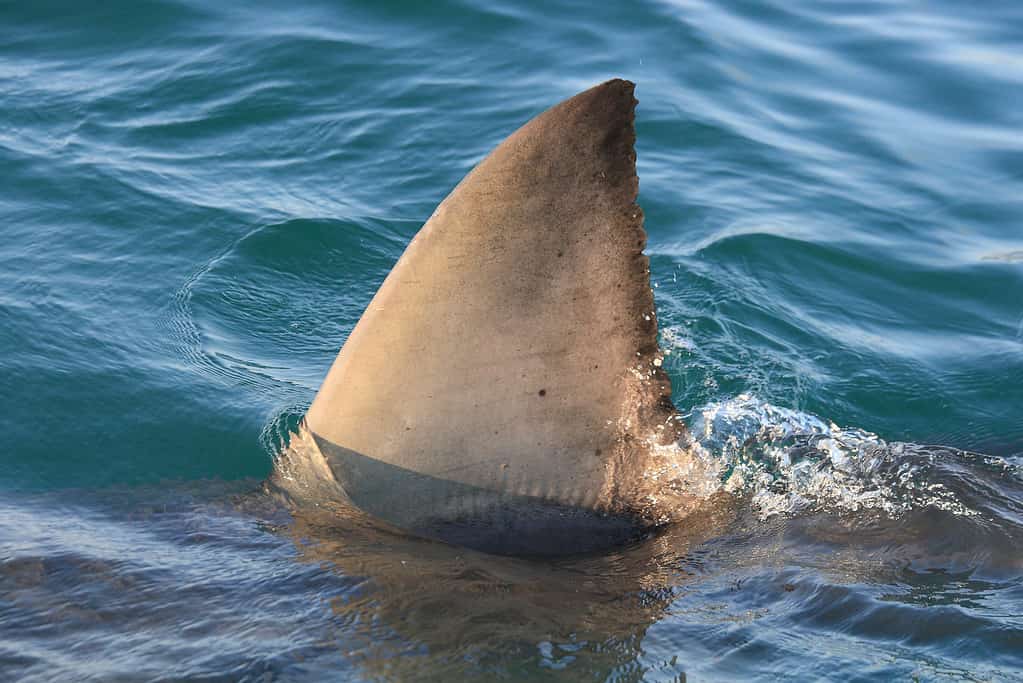
Fearsome fin: Aggressive shark or not, you don’t love to see it.
©iStock.com/Alessandro De Maddalena
When it comes to interaction between sharks and human beings, aggression doesn’t seem to play a big part. (Unless we’re talking about aggression by the human.) An unprovoked shark “attack” may be the shark exploring its environment, using sense organs in its mouth to determine if an unknown object is good to eat. Different species have different ways of behaving. Some may be territorial at times, or may sometimes be encountered in a heightened predatorial state that makes them more likely to attack. Of course, whatever the reason, even an exploratory bite from a large shark might be harmful or even lethal. But factors like rising human populations in coastal areas, loss of habitat, and climate change may be the bigger factors in explaining why shark encounters occur.
Which Sharks Are More Likely to Bite Humans?
It’s true that some species of sharks are more associated with shark attacks, so we might use that as a marker for shark aggression. But it’s important to realize that not all sharks are easily identified (especially when you suddenly find that your foot is in its mouth). So a list of the species implicated in shark attacks will be skewed towards the ones that are easy to recognize. Some sharks may be more frequently involved than the data shows, and other species may be overrepresented.
With that in mind, let’s look at the most aggressive sharks that are found in U.S. waters, at least in terms of reported shark attacks.
1. Bull Sharks
Carcharhinus leucas
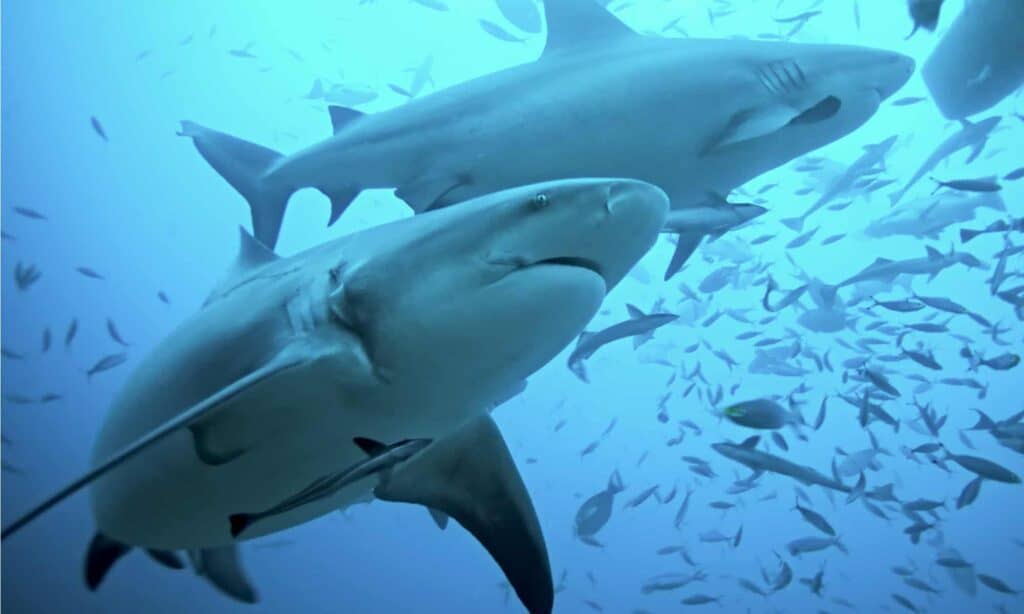
Bull sharks are widely regarded as the most dangerous.
©Martin Prochazkacz/Shutterstock.com
# of confirmed attacks, ISAF, 2011-2021: 119
These sharks aren’t the biggest, and they rank third on the ISAF list of the number of confirmed shark attacks. But bull sharks are regarded as the most dangerous sharks in the world. Along with their reputation for aggressive behavior, their large size and the fact that they favor coastal waters worldwide and can live in freshwater (some have been reported in the Mississippi River in Illinois), contributes to their dangerous reputation.
2. Great White Sharks
Carcharodon carcharias
# of confirmed attacks: 351
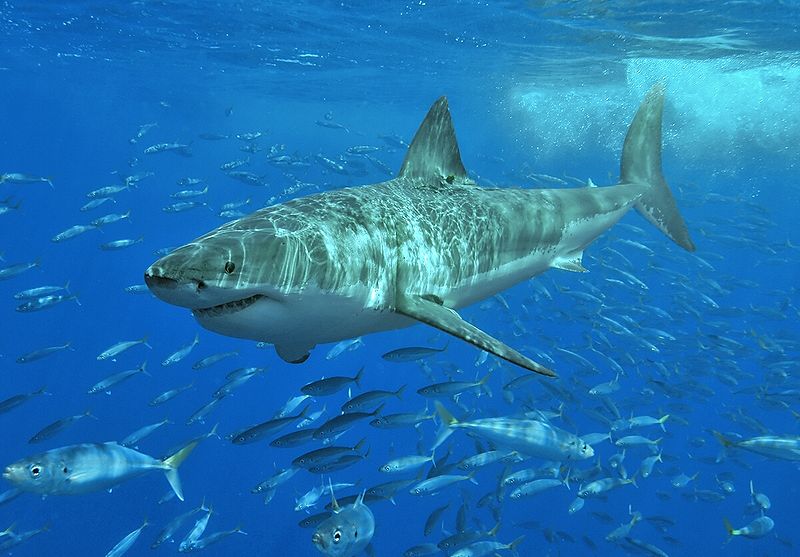
The great white shark is smarter than it looks.
Also known as the “great white” shark, this is the iconic species made famous by that “We’re gonna need a bigger boat” movie. You know the one. They’re first on the ISAF shark attack list. This may be because they sometimes mistake swimming humans for their usual prey. Also, these are massive, powerful animals, the largest predatory fish on earth. So any bite is more likely to do significant damage. That said, there are documented reports of researchers and divers finding white sharks to be calm and docile. These sharks seem to be more intelligent than we once thought, so their behavior may be more complex than we realize.
3. Tiger Sharks
Galeocerdo cuvier
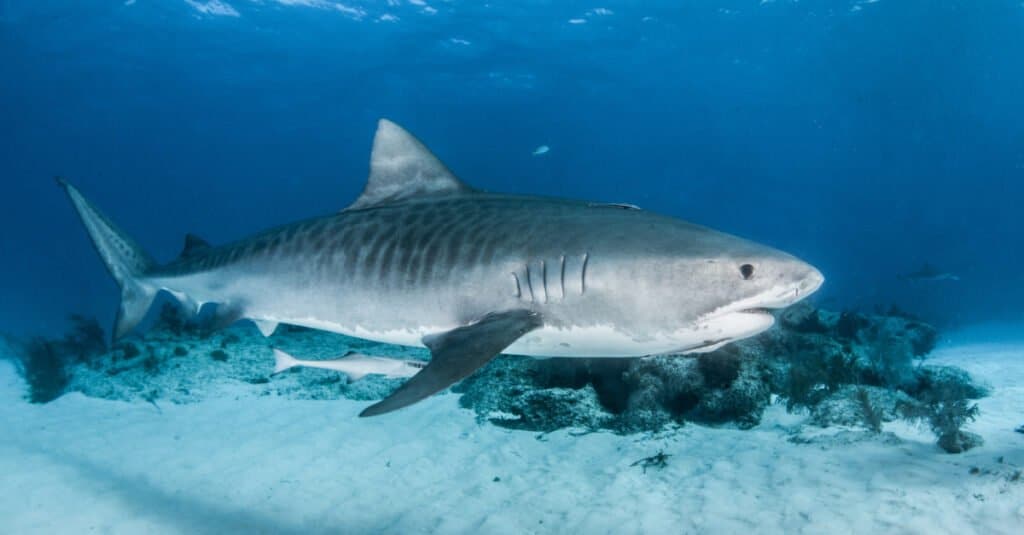
Tiger sharks are fearsome predators but are also known to eat almost anything that crosses their path.
©iStock.com/Divepic
# of confirmed attacks: 142
They take their name from their striped markings, which tend to fade with age. But like their terrestrial namesakes, tiger sharks are ambush predators that dispatch their prey with a sudden burst of speed. With bulls and whites, tiger sharks are in the “big three” of shark species most implicated in unprovoked attacks on humans. The Florida Museum of Natural History describes them as “unaggressive.” But their involvement in shark attacks may be a consequence of their curiosity, large size (second to the white shark), and scavenging nature (they’re known for eating almost anything, including trash dumped into the ocean by humans).
4. Unidentified Requiem Sharks
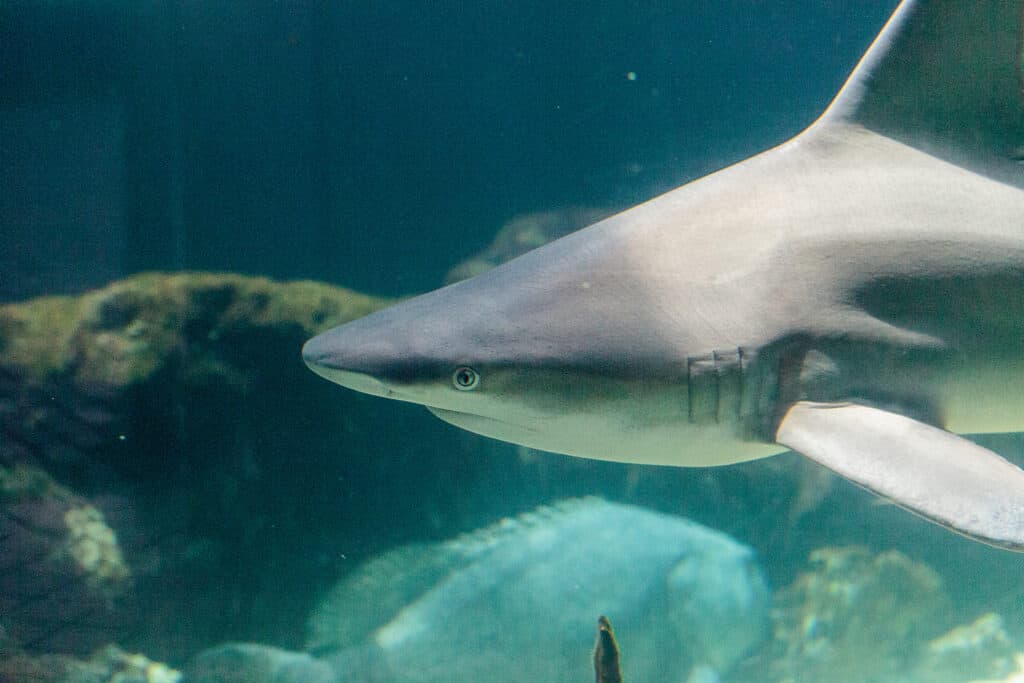
Requiem sharks, like this blacknose shark, can be hard for amateurs to identify.
©iStock.com/LagunaticPhoto
# of confirmed attacks: 51
Also called carcharhinid sharks, this is a group of about 50 shark species, including some coastal species found in U.S. waters. That includes some sharks mentioned elsewhere on this list, like the bull shark and tiger shark. Many of them are similar in appearance, so it’s hard to identify them.
5. Sand Tiger sharks
Carcharias taurus
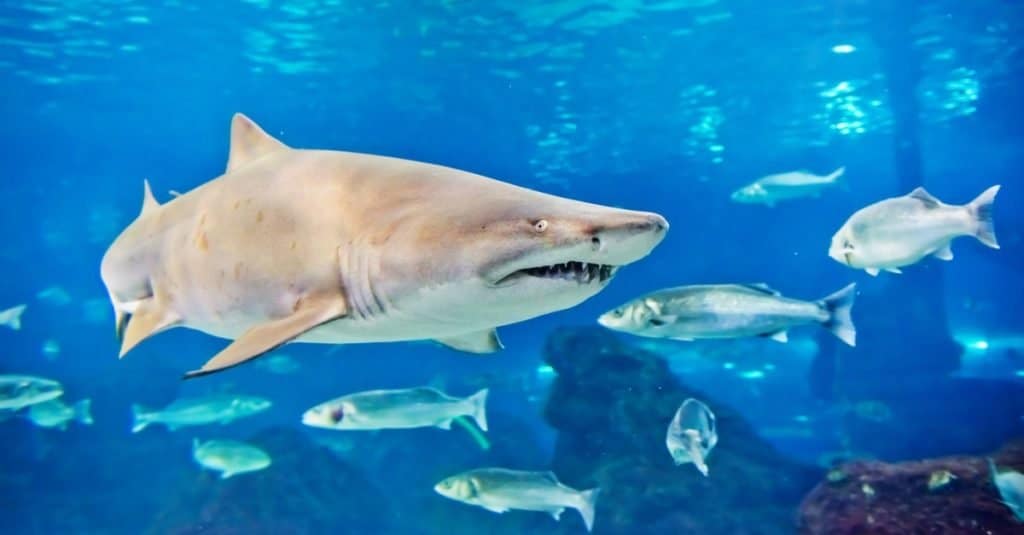
Gulp! Sand tiger sharks have figured out how to float by swallowing air.
©Valeri Potapova/Shutterstock.com
# of confirmed attacks: 36
Large and slow-moving, sand tiger sharks tend not to be aggressive unless provoked. But they are known to try and steal fish from spearfishers, sometimes leading to a bite. An interesting behavior of sand tiger sharks is that they’ll come to the surface to take a gulp of air, which increases their buoyancy and allows them to float motionless in the water. Most sharks will sink if they stop swimming.
6. Blacktip sharks
Carcharhinus limbatus

Blacktip sharks frequent shallow waters.
©Gino Santa Maria/Shutterstock.com
# of confirmed attacks: 35
Statistically equivalent to sand tigers in terms of the number of attacks, blacktips are actually timid fish for the most part. But they prefer to hunt small fish in shallow waters, which increases the likelihood of a shark-human encounter. Fortunately, a blacktip that mistakenly bites a human typically leaves only a minor injury.
How to Prevent A Shark Attack

Safety in numbers: Swim with a group to reduce your risk.
©Sergey and Marina Pyataev/Shutterstock.com
It’s incredibly rare for a shark to attack a human. But there are simple practices you can follow to make this unlikely event even less likely.
Don’t swim alone. Sharks are less likely to approach a group of swimmers or divers.
Don’t swim at dawn or dusk. Those are the times when sharks are more likely to be feeding near shore.
Don’t swim where fish are. Where there are fish, there may be sharks preying on them. Avoid swimming near fishing boats or where people are fishing. Also, avoid spots where you see diving seabirds; that’s an indicator of fish below the surface. And avoid deep channels, troughs between sandbars, and spots where the sea bed suddenly drops off.
Don’t swim in murky water. If underwater visibility is poor, it’s harder for a shark to tell that you’re not prey.
Don’t wear jewelry when swimming, or anything else shiny. It’s thought that light bouncing off shiny objects might seem like fish scales to a shark.
Pay attention to local warnings and cautions about sharks in the area.
Summary of the 6 Most “Aggressive” Sharks in U.S. Waters
| Rank | Shark Breed | Scientific Name | Characteristics |
|---|---|---|---|
| 1 | Bull Shark | Carcharhinus leucas | A rep for aggression |
| 2 | White Shark | Carcharodon carcharias | The world’s largest predatory fish |
| 3 | Tiger Shark | Galeocerdo cuvier | Curious and omnivorous |
| 4 | Requiem Sharks | Carcharhinus spp. | Multiple species |
| 5 | Sand Tiger Sharks | Carcharias taurus | Caution for spearfishers |
| 6 | Blacktip Sharks | Carcharhinus limbatus | Likes shallow water |
The photo featured at the top of this post is © Wirestock Creators/Shutterstock.com
Thank you for reading! Have some feedback for us? Contact the AZ Animals editorial team.







